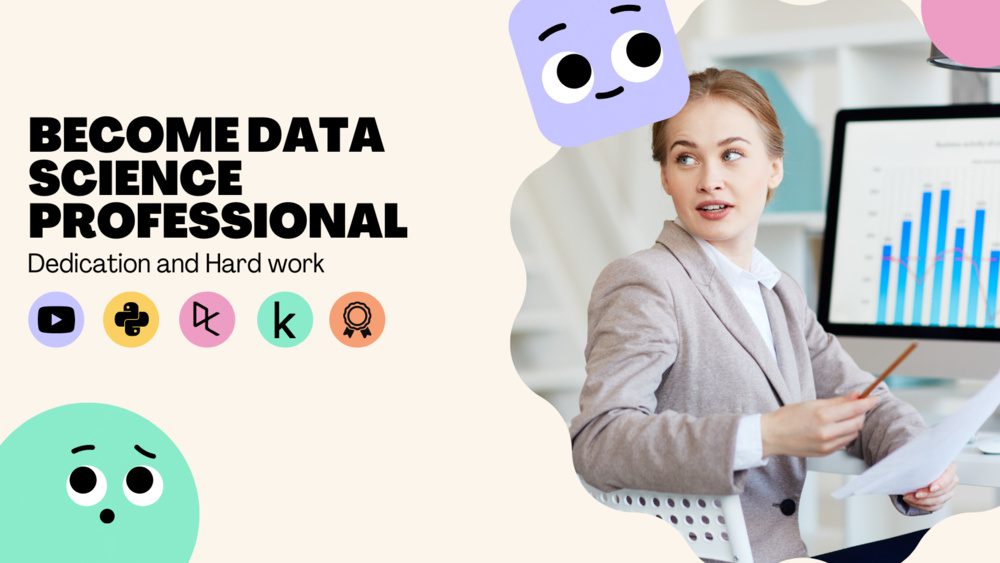
Image by author
A typical beginner will spend a couple of hours on Google searching for data science courses and most of them give up. Why is that? It is because we have multiple options to start and we could not figure out what works best for us. In my opinion, we all are just lost in the stockpile of content and we don’t know where to start. In this blog, I will guide you on what worked for me and maybe it can work for you too.
The guide includes:
- Learning basics of data science
- Getting good at programing language
- Taking full data science track
- Getting a hands-on experience on data science projects
- Getting data science certification
Learning data science fundamentals is the most important part of your journey, as it will prepare you for the learning challenges. Most of the beginners will dive into courses without knowing what they want to achieve. In the end, 90% don’t even complete the course as things get harder with time. So, if you are following the trend, then please learn about data science and the career path.

Image by Karolina Grabowska from pexels
Start by learning the basics of statistics and data science by watching beginner friendly video tutorials. These non-technical videos will help you understand various components of data science; data ingestion, data cleaning, data analyzing, modeling, and applications. If you don’t like watching videos, you can also try reading blogs and books. Learning data science essentials will help you understand the career path and introduce you to the most common tools used for data analytics and machine learning.
Learning Resources:
After learning the basics, it’s time to master Python as you are going to code most of your time at your job. You can also start with R or Julia as they were inherently developed for statistics and scientific research. Mastering Python will help you with research, data visualization, designing state-of-the-art applications, and clearing technical interviews.

Image by author
I started my journey by learning R and Python. It helped me learn core concepts of data analysis faster. Afterwards, I started learning SQL, which is the most important tool for data ingestion and analysis. Almost all data science interviews will include SQL questions so, it’s better to learn it at an early stage to improve your odds of getting hired.
Learning resources:
Bonus:
The data science track contains all necessary courses for you to master; data management, exploratory analysis, statistical experimentation, model development, programming, and reporting. The career track also provides you with a structure and interactive coding exercises. These courses will help you understand the core concepts of statistics, machine learning, and natural language processing.

Image by author
My journey started with the Python data science career path which helped me understand data analysis and machine learning. The interactive sessions have improved my coding skills. In my opinion, the career tracks that come with interactive exercises, coding challenges, assignments, and projects are the best. They will keep your progress in check and help you improve with time.
Interactive Career Tracks:
It’s time to apply your skills to the real world but it’s hard to find a job immediately unless you have some experience in the field. How do you get experience? By participating in data science competitions, volunteering in NGO projects, or applying for internships.

Image by author
Participate in a Competition
Participating in data analysis or machine learning competitions will help you build a data science portfolio. It will also help you understand various real-life problems such as forecasting, machine learning in health care, robotics, and computer vision. The data science track introduced me to the world of data, and Kaggle competitions have shaped me into a data science professional. I highly recommend everyone to participate in competitions and learn from other participants.
Competitions Platforms:
Work on Projects
You can also volunteer for NGO projects where the barrier of entry is quite low. If you are looking for collaborative experience, I will suggest that you check out Omdena projects. To improve your data science portfolio, try looking for beginner-friendly projects. Do not restrict yourself to jobs, you can also gain experience by contributing to open-source projects.
Internships
Last but not least is the internship option. You can find apprenticeships, summer camp invitations, or internships on LinkedIn or on the local job boards. Internships are your first set into the professional world and it is the express way of getting a full time job. If you are struggling to find an internship, then ask your friend or post on LinkedIn. Getting professional experience is necessary for you to succeed in the field.
Getting a data science certification will give you an edge in the job market. The certification examination is hard to pass. It will test your knowledge of programming, data management, modeling, and reporting. It’s better to get some beginner-level experience in data science projects before taking certification tests.

Image by author
It took me two weeks to clear all the challenges. First challenge was timed assessments which tested my knowledge of SQL, Python, and Statistics. Then, I was promoted to a coding challenge that took me an entire day to solve. The last part was a case study, which included writing the technical report and a non-technical presentation. After getting certification, I received career service from DataCamp free of cost, which had helped me ace multiple job interviews. If you want to know more about my journey then check out my blog: How to Get Certified as a Data Scientist.
List of top data science certification:
The next step is to find a full-time job in any sub-field of data science. While you wait to get hired, it’s better to keep learning new tools and work on projects. You can also join data science communities or write blogs about things you have learned.
Sign up for freelance platforms, participate in competitions, read about new research topics, create your portfolio on GitHub, Deepnote, DAGsHub, and Kaggle. It is important to keep learning and keep growing if you want to get noticed by top companies like Meta and Google.
If you are looking for project inspiration, check out my profile on Deepnote, Kaggle, GitHub, and DAGsHub. You can also follow me on LinkedIn to learn more on beginner-friendly projects, read blogs, and tutorials. If you have any queries about the data science career path please comment below and I will try my best to answer all of your questions.
Abid Ali Awan (@1abidaliawan) is a certified data scientist professional who loves building machine learning models. Currently, he is focusing on content creation and writing technical blogs on machine learning and data science technologies. Abid holds a Master’s degree in Technology Management and a bachelor’s degree in Telecommunication Engineering. His vision is to build an AI product using a graph neural network for students struggling with mental illness.
